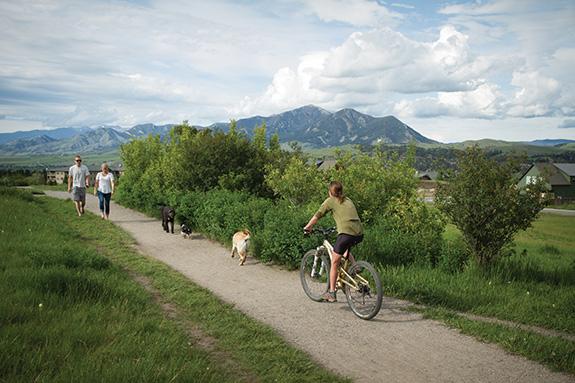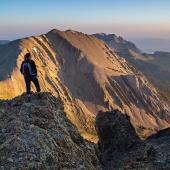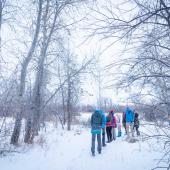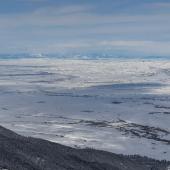For Peets Sake
Remembering Mary Vant Hull.
A bench dedicated to Mary Vant Hull sits atop Peets Hill overlooking Bozeman, the city she deeply loved. It’s an apt place to remember the community activist who died on January 1, 2017, at the age of 89.
Known for her quirky yet unforgivingly tenacious personality, Mary was responsible for many of the outdoor amenities that define Bozeman and the Gallatin Valley. From the Galligator Trail, streamside-setback regulations, and Centennial Park to the first-ever countywide open-space bond, the Dinosaur Playground, and the nearly completed dog park at Gallatin County Regional Park, Mary left a legacy not soon to be forgotten.
But Peets Hill—that was special. Mary fought to make it Bozeman’s first leash-free park and to pass an ordinance limiting building heights so views were never obstructed. She was there almost daily, often on her bicycle and always with a dog or two. She’d catalogue wildflowers, walk the trails, and even scoop poop.
Penelope Pierce, executive director of the Gallatin Valley Land Trust, calls Mary “the guardian” of Peets Hill. “She’d patrol it and tell us about the ‘social trails’ [vegetation-damaging unauthorized tracks] that were being created,” Pierce says.
Saying Mary was unique is an understatement. Since the early 2000s, her Story Street home was marked by something unusual on the garage roof: a crocodile, a bicycle, a coyote. The house was crammed with whimsical objects—carvings, quilts, artwork—many depicting bicycles and dogs.
Fierceness, courageousness, bluntness, and honesty were Mary’s hallmarks. She didn’t give up easily and excelled at recruiting others to join her quests. “Her astonishing talent was getting stuff done,” says Dorothy Bradley, Mary’s longtime friend and a former state legislator. “She looked at all her friends as a wonderful apple tree and she’d figure out which apple to pick to get things done. She’d lure us to her house with borscht soup or apple crisp and we’d think we were in for a lovely catch-up moment with Mary. Then she’d lay out her next project and we would be the people who’d be involved—that’s how she got things done.”
Pierce agrees. “One thing I loved about her,” she says, “She was like a dog on a bone once she felt that something needed to be done. She was a real force of nature.”
Mary spoke of her tenacity in a 2014 interview with the Bozeman Daily Chronicle. “The truth is that if you are tedious and optimistic, you can change things,” she’d said. Her daughter, Melinda Tyler, says that Mary once threatened to chain herself to the doors of the library until city commissioners agreed to build a larger one. Mary never used chains, but she did win her case, recruiting people to write notes on their water bills.
In 1983, City Commissioner Vant Hull voiced her vision for Bozeman in 100 years: residents “would have decided that they were not going to be overrun by automobiles,” she’d told the Chronicle. When Marilee Brown began her quest for a path from Belgrade to Bozeman, she had no idea Mary had been advocating it for years; Brown was likely Mary’s last conscript.
At a meeting of the Bozeman Area Bicycle Advisory Board, Brown spoke about the path. Mary was in attendance. “Mary did a very typical thing for her,” Brown says. “She scribbled a note to me saying, ‘I think you’re wonderful. Would you come to my house tomorrow for lunch?’”
With that, Mary had picked another apple. The Galla10 Alliance for Pathways (GAP) is dedicated to the connector path and memorialized Mary in its bylaws. “I’m just sad she died before we were able to form this nonprofit,” Brown says. “She would have been so thrilled and supportive.” And though Tyler notes that it was challenging to live in her mother’s looming shadow, she is proud of what her mother accomplished. “She left a very small imprint on the planet, but she left a huge imprint on Bozeman.”
Know another legacy-leaver who made Bozeman a better place before passing on? Email [email protected].












